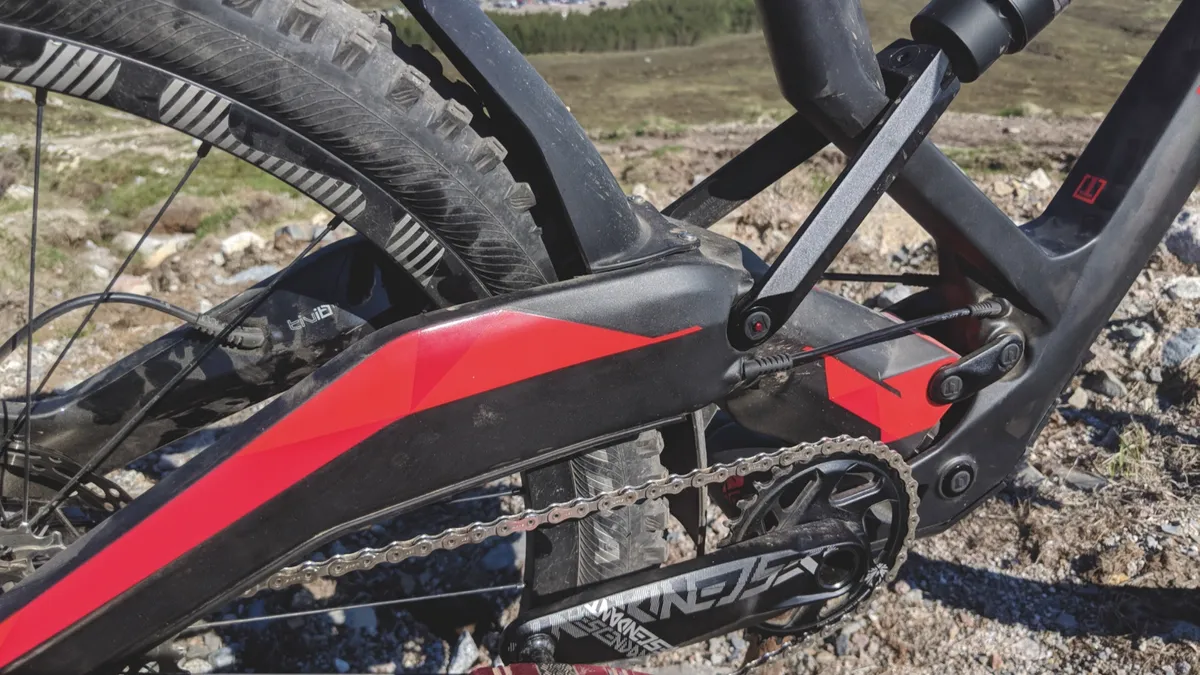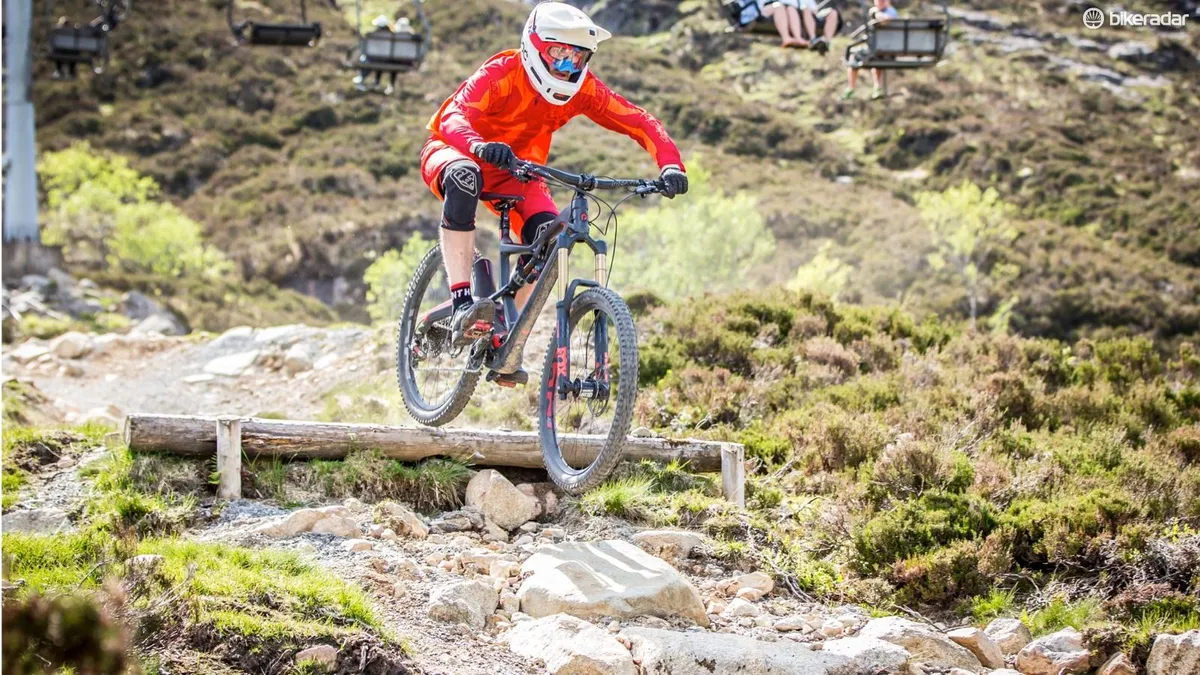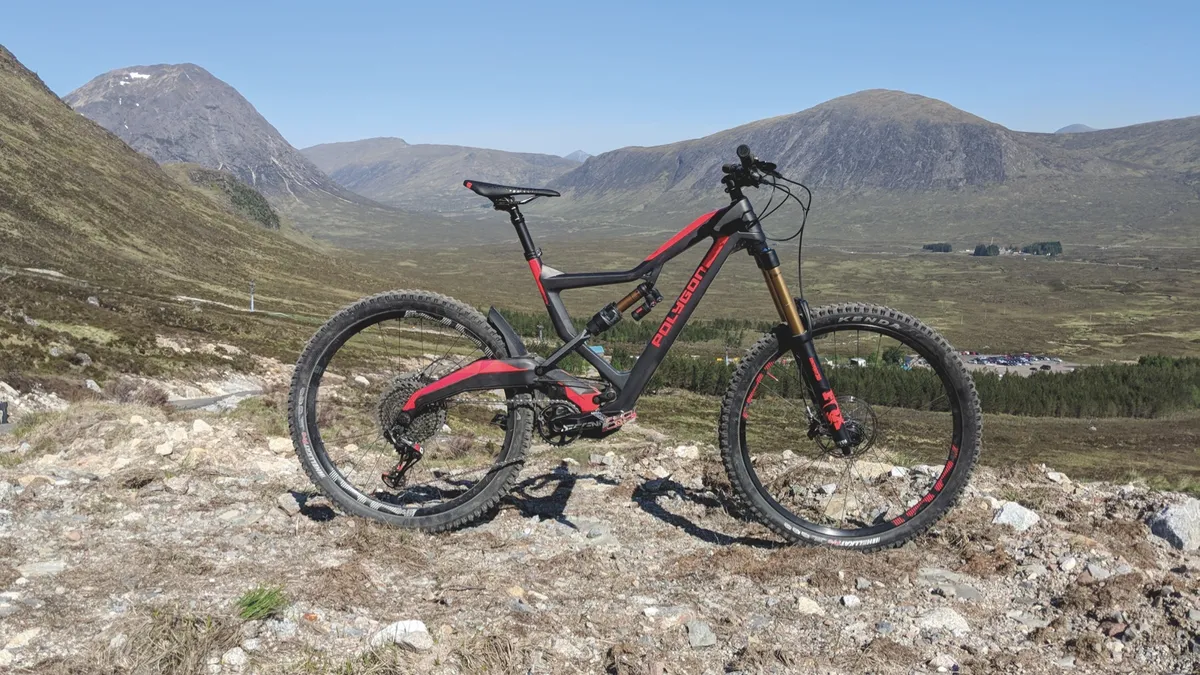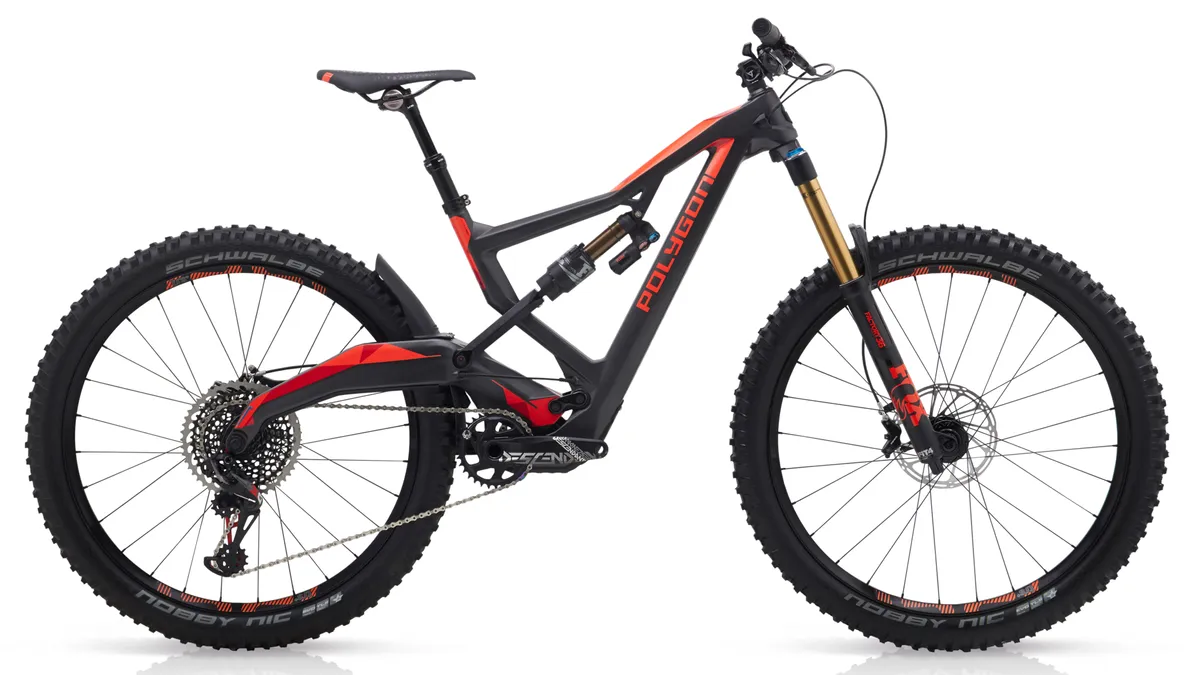The defining characteristic of the Polygon Xquarone EX8 is its radical rear suspension. It’s the brainchild of a company called Naild, and has different ride characteristics to any other system out there.
Despite its 180mm of travel, the Xquarone (“square one”) is claimed to pedal superbly, making it a versatile all-mountain bike.
- How to get your suspension setup dialled
- The ultimate guide to mountain bike rear suspension systems
Polygon Xquarone EX8 specifications
- Frame: Carbon fibre, 180mm (7.1in) travel
- Fork: Fox 36 Float FIT4 Factory, 180mm (7.1in) travel
- Shock: Fox Float X2 Factory
- Cranks: Truvativ Descendant
- Derailleur: SRAM X01 Eagle 12spd
- Shifters: SRAM X01 Eagle 12spd
- Wheelset: e*thirteen TRS+ wheels
- Tyres: Schwalbe Nobby Nic 27.5x2.6in
- Brakes: SRAM Guide RSC, 180mm rotors
- Bar: Race Face Next R carbon, 780mm
- Stem: Race Face Turbine R, 50mm
- Seatpost: KS LEV SIO 150mm dropper
- Saddle: Entity Assault
Polygon Xquarone EX8 frame
While the carbon fibre mainframe is designed by Polygon, the swingarm (also carbon) is supplied by Naild, but is specifically designed to work with this bike. It slides up and down on a large cylindrical stanchion, which is mounted on a pivot just in front of the chainring.
The path of the rear wheel is controlled by this pivoting stanchion, along with a pair of short links which connect the swingarm to the frame higher up. These links are also key to the rear-end stiffness, as the swingarm would otherwise be free to rotate laterally around the stanchion.

A pair of large bushings and a downward-facing seal minimise friction between the swingarm and the stanchion. When the shock was removed, the rear suspension moved freely with no more friction than a more conventional pivot-only design, even when a lateral load was applied to the swingarm.
The suspension is controlled by a Fox Float X2 shock with a particularly light damping tune.
Polygon Xquarone EX8 kit
It may be the lower-specced of the two Xquarone models, but the EX8’s components leave little to be desired.
Fox’s 36 FIT4 is still among our favourite forks, while SRAM’s X01 Eagle gearing provides all the range and refinement you’ll ever need.
The Guide RSC brakes perform well too, though, on a bike of this travel, I’d like a bigger front rotor. My only real complaint is with the KS LEV SIO dropper, which has a layback head that effectively slackens the seat angle — I’d prefer an inline post.
Polygon Xquarone EX8 ride impressions
The most impressive thing about this bike is how it pedals. Forget how much travel it has, no matter the gradient, cadence or power output, the suspension is remarkably stable when seated. That means it forgives even choppy pedalling technique with almost hardtail-like efficiency.
When sprinting out of the saddle, there is a little suspension bob, but less than on most mid-travel trail bikes. Normally, bikes that climb efficiently sacrifice some suspension sensitivity. The Naild system is somewhat different.
The Polygon works best with a firm spring rate (around 25 percent sag)
The Xquarone’s suspension design and light shock tune give it a supple, almost ‘floating’ feel on bumpy trails that keeps it comfortable and stops it hanging up on the faces of obstacles.
Interestingly, this isn’t what I found with Marin’s Wolf Ridge, which uses its own variation of Naild’s ‘R3ACT’ system. That bike had a more jarring ride, especially when pedalling. The difference could be down to the Polygon’s extra 20mm of travel, its shock tune or its slightly different suspension kinematics.
I also found that the Marin’s back end flexed so much, laterally, in certain situations that the shock would bind, causing the suspension to become suddenly harsh. The Xquarone appears to be stiffer, both when wiggling the rear wheel from side to side and when riding. I didn’t notice the shock binding while testing; in fact the suspension remained impressively active and supple throughout.

The Polygon works best with a firm spring rate (around 25 percent sag). I left the compression damping fully open and the rebound a little faster than normal, according to Naild's recommendation. When descending, the suspension was impressively active over repeated rock hits, this encourages the rider to drop their heels and allow the bike to do its work.
The rear wheel moves up and over objects with very little fuss, and the bike maintains momentum through bumpy sections brilliantly. I'm not sure to what extent this is down to the suspension layout, and how much is down to the unusually light damping. Either way, when the terrain is rough and fast (but not too steep) the Polygon is very easy to ride.
On the flipside, the stiffly-sprung and lightly-damped suspension makes for a less than settled ride in steep, steppy sections. And, as with the Marin, I occasionally noticed the cranks trying to rotate backwards under sudden compressions (known as pedal-kickback), especially when the rear wheel was locked up.
At 85kg, I ran 240psi in the rear shock, suggesting heavier riders may want more pressure than the maximum recommended pressure of 250psi. The proprietary rear axle also worked loose at one point, and was a pain to refit.
Where the Xquarone really comes unstuck though, is with its geometry. The slack 73.5-degree seat angle and layback post put the rider’s weight too far back over the rear axle, making steep climbs awkward.
Fitting an inline post would help, but would make the cockpit — which is already short by modern standards (the XL I tested had a reach of 471mm) — feel cramped.
When descending, the short front-centre, relatively steep (for the travel) 66-degree head angle and high rear spring rate push the rider’s weight forward, making for a nervous ride on steep, technical trails. I had to run the fork harder than normal and ride over the back of the bike to compensate. This made the Polygon tiring on prolonged descents.
Polygon Xquarone EX8 early verdict
The Xquarone’s suspension has its advantages, but the ride is hampered by conservative geometry.


